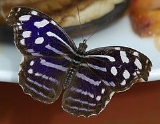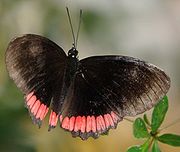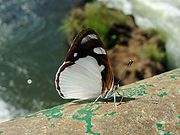
Biblidinae
Encyclopedia




Nymphalidae
The Nymphalidae is a family of about 5,000 species of butterflies which are distributed throughout most of the world. These are usually medium sized to large butterflies. Most species have a reduced pair of forelegs and many hold their colourful wings flat when resting. They are also called...
butterflies
Butterfly
A butterfly is a mainly day-flying insect of the order Lepidoptera, which includes the butterflies and moths. Like other holometabolous insects, the butterfly's life cycle consists of four parts: egg, larva, pupa and adult. Most species are diurnal. Butterflies have large, often brightly coloured...
that includes the tropical brushfoots. This subfamily was sometimes merged within the Limenitidinae
Limenitidinae
Limenitidinae is a subfamily of butterflies that includes the admirals and relatives. The common names of many species and genera reference military ranks or – namely the Adoliadini – titles of nobility , in reference to these butterflies' large size, bold pattern and dashing flight...
, but they are now recognized as quite distinct lineages. In older literature, this subfamily is sometimes called Eurytelinae.
As of 2008, there are some 340 valid species in this subfamily, placed in 38 genera. Most species of Biblidinae are neotropical, but some Old World species and genera in Biblidini and Epicaliini.
Systematics
The Biblidinae are a taxonomically stable monophyletic group, at least since the "wastebin genusWastebin taxon
Wastebasket taxon is a term used in some taxonomic circles to refer to a taxon that has the sole purpose of classifying organisms that do not fit anywhere else. They are typically defined by their lack of one or more distinct character states or by their not belonging to one or more other taxa...
" "Catagramma
Catagramma
"Catagramma" is an obsolete genus of Neotropical butterflies; the name continues to be used e.g. among butterfly collectors as a form taxon. "Catagramma" species are popularly known as "88s", in reference to a pattern on the hindwing undersides of many that looks like the number 88...
" was dismantled around 1950. Six tribes
Tribe (biology)
In biology, a tribe is a taxonomic rank between family and genus. It is sometimes subdivided into subtribes.Some examples include the tribes: Canini, Acalypheae, Hominini, Bombini, and Antidesmeae.-See also:* Biological classification* Rank...
are recognized, and the monophyly of them all is likewise well supported; radical changes in taxonomy
Taxonomy
Taxonomy is the science of identifying and naming species, and arranging them into a classification. The field of taxonomy, sometimes referred to as "biological taxonomy", revolves around the description and use of taxonomic units, known as taxa...
and systematics
Systematics
Biological systematics is the study of the diversification of terrestrial life, both past and present, and the relationships among living things through time. Relationships are visualized as evolutionary trees...
are not expected in this subfamily. The sister group to the Biblidinae is probably the Apaturinae
Apaturinae
Apaturinae is a subfamily of butterflies that includes many species commonly called "emperors".-External links:* List of North American species with images.* Images.In Japanese but binomial names....
and/or Nymphalinae.
The tribes, in the presumed phylogenetic sequence and with notable genera and some species also listed here, are:
Biblidini Boisduval, 1833
- Biblis Fabricius, 1807 (= Zonaga)
- Ariadne Horsfield, 1829 (= Ergolis)
- Ariadne ariadneAriadne ariadneAriadne ariadne, also known as the Angled Castor, is a species of nymphalid butterfly found in Asia.-Description:Males and females have fore wing truncate at apex; termen angulated at interspace 5, and again at apex of vein 3, concave between; tornus obtusely angulate. Hind wing: termen more or...
– Angled Castor - Ariadne merioneAriadne merioneAriadne merione, also known as the Common Castor, is an orange butterfly with brown lines whose larvae feed almost exclusively on Castor Ricinus communis. It is similar in appearance to Ariadne ariadne, the Angled Castor....
– Common Castor
- Ariadne ariadne
- Laringa Moore, 1901
- EurytelaEurytelaEurytela is a genus of nymphalid butterfly, commonly called Pipers, found in Africa.-Species:Listed alphabetically.*Eurytela alinda Mabille.1893*Eurytela dryope – Golden Piper...
Boisduval, 1833 - Neptidopsis Aurivillius, 1898
- Mesoxantha Aurivillius, 1898
- BybliaBybliaByblia is a genus of nymphalid butterfly, commonly called Jokers, found in the Africa and the Indian subcontinent.These butterflies are orange with black markings...
Hübner, 1819 (= Hypanis Boisduval, 1833 (non Pander in Menetries, 1832: preoccupied))- Byblia ilithyiaByblia ilithyiaThe Joker or Spotted Joker is a species of nymphalid butterfly found in parts of Africa and Asia.-Wet-season form:...
– (Common) JokerByblia ilithyiaThe Joker or Spotted Joker is a species of nymphalid butterfly found in parts of Africa and Asia.-Wet-season form:...
- Byblia ilithyia
- Mestra Hübner, 1825 (= Cystineura)
- Archimestra Munroe, 1949
- Vila Kirby, 1871 (= Lonia, Neptis Hübner, 1819 (non Fabricius, 1807: preoccupiedNeptisNeptis is a large genus of butterflies of Old World tropics subtropics. They are commonly called sailer butterflies or sailers, or more precisely typical sailers to distinguish them from the related blue sailers ....
), Olina Doubleday, 1848 (non Robineau-Desvoidy, 1830: preoccupied))
Epicaliini Guenée, 1865
- CatonepheleCatonepheleCatonephele is a nymphalid butterfly genus found in Mexico, Central America, South America, and the West Indies.Species include:* Catonephele acontius * Catonephele antinoe* Catonephele chromis...
Hübner, [1819] - NessaeaNessaeaNessaea is a genus of nymphalid butterfly found in the Neotropical Ecozone. Unlike virtually all other butterflies with blue coloration, the blue colors in this genus are due to pigmentation rather than iridescence .-Species:...
Hübner, [1819]
- MysceliaMysceliaMyscelia is a genus of nymphalid butterfly found in southern North America, Central America, and northern South America.-Species:* Myscelia aracynthia * Myscelia capenas * Myscelia cyananthe C. & R...
Doubleday, 1844 (= Sagaritis Hübner, 1821 (non Billberg, 1820: preoccupied), Sea)
- SeveniaSeveniaSevenia, commonly called tree nymphs, is a genus of forest butterflies in the Nymphalidae family that, as larvae, feed on plants of the Euphorbiaceae family. There are 14 species from continental Africa and 2 species from Madagascar...
Koçak, 1996 (= Crenis Boisduval, 1833 (non Hübner, 1821: preoccupiedHeliconiusHeliconius comprise a colorful and widespread brush-footed butterfly genus distributed throughout the tropical and subtropical regions of the New World. These butterflies utilize Passion flower plants as their larval food source and rely on bright wing color patterns to signal their distastefulness...
), Sallya Hemming, 1964 (non Yochelson, 1956: preoccupied))- Sevenia boisduvaliSevenia boisduvaliSevenia boisduvali is a butterfly in the Nymphalidae family, and commonly known as Boisduval’s Tree Nymph. There are four subspecies; all native to Africa.-Description:The following is a description for Sevenia boisduvali boisduvali:...
- Boisduval's Tree Nymph - Sevenia morantiiSevenia morantiiThe Morant's Tree Nymph or Obscure Tree Nymph is a butterfly in the Nymphalidae family found in southern Africa.Wingspan: 40–45 mm in males and 43–50 mm in females....
- Morant's Tree Nymph - Sevenia natalensisSevenia natalensisThe Natal Tree Nymph is a butterfly in the Nymphalidae family found in southeastern Africa.Wingspan: 40–48 mm.Flight period year-round, peaking between February and May....
- Natal Tree Nymph - Sevenia rosaSevenia rosaThe Rosa's Tree Nymph is a butterfly in the Nymphalidae family found in South Africa.Wingspan: 50–60 mm in males and 52–62 mm in females.Flight period is recorded as October to January but might be year-round....
- Rosa's Tree Nymph - Sevenia trimeni - Trimen's Tree Nymph
- Sevenia boisduvali
- EunicaEunicaEunica is a genus of nymphalid butterfly found in the Neotropical Ecozone.- Species list :Note: Names preceded by an equal sign are synonyms. ORIG indicates original name...
Hübner, [1819]
- Cybdelis Boisduval, 1836
Ageroniini Doubleday, 1847
- Hamadryas – cracker butterflies, calico butterflies
- Ectima Doubleday, 1848
- PanaceaPanacea (butterfly)Panacea is a brush-footed butterfly genus.- Species :Listed alphabetically.* Panacea bleuzeni Plantrou & Attal, 1986* Panacea chalcothea * Panacea divalis * Panacea procilla...
Godman & Salvin, 1883 (= Pandora Doubleday, 1848 (non Lamarck, 1799: preoccupied)) - BatesiaBatesia (butterfly)Batesia is a genus of butterfly of the Nymphalidae family containing only one species, the Painted Beauty . It is found in the upper Amazon areas of Brazil, Ecuador and Peru.The wingspan is 85-95 mm...
Felder & Felder, 1862
Epiphilini Jenkins, 1987
- AsteropeAsterope (butterfly)Asterope is a genus of brush-footed butterflies found in the Neotropical Ecozone.-Species:* Asterope batesii* Asterope buckleyi* Asterope degandii* Asterope leprieuri* Asterope markii* Asterope sapphira...
Hübner, [1819] - Pyrrhogyra Hübner, 1819 (= Corybas)
- Epiphile Doubleday, 1844
- Lucinia Hübner, 1823 (= Autodea)
- Bolboneura Godman & Salvin, 1877
- Temenis Hübner, 1819 (= Callicorina, Paromia Hewitson, 1861 (non Westwood, 1851: preoccupied))
- Nica Hübner, 1826 (= Pseudonica)
- Peria Kirby, 1871 (= Pelia Doubleday, 1849 (non Bell, 1836: preoccupied))
Eubagini Burmeister, 1878
- Dynamine Hübner, 1819 (= Arisba, Eubagis, Sironia)
Callicorini Orfila, 1952 – eighty-eights and relatives
- DiaethriaDiaethriaDiaethria is a brush-footed butterfly genus found in the Neotropical Ecozone, ranging from Mexico to Paraguay.Species in this genus are commonly called eighty-eights like the related genera Callicore and Perisama, in reference to the characteristic patterns on the hindwing undersides of many...
Billberg, 1820 - CallicoreCallicoreCallicore is a genus of nymphalid butterfly found in the Neotropical Ecozone. This genus, like some related ones, was formerly lumped together as the paraphyletic "Catagramma" assemblage....
Hübner, [1819] - Perisama Doubleday, 1849 (= Orophila)
- Antigonis Felder, 1861 (= Lincoya)
- Haematera Doubleday, 1849 (= Callidula)
- Paulogramma Dillon, 1948
- Catacore Dillon, 1948
External links
- The higher classification of Nymphalidae, at Nymphalidae.net
- Markku Savela's Lepidoptera and some other life forms: Preliminary species list. Version of 2007-MAR-18. Retrieved 2007-MAY-30.
- Pteron Misspelt as Biblinae.Images. In Japanese but binomial names.

